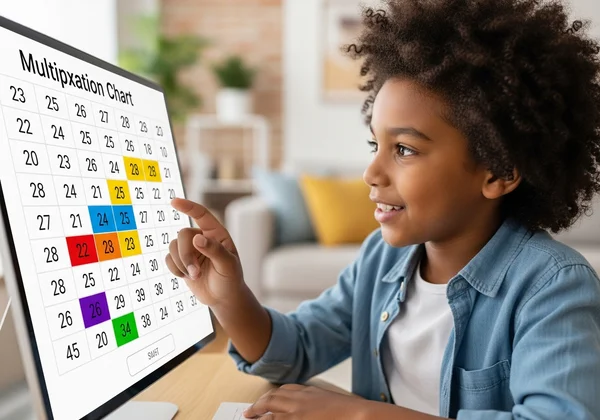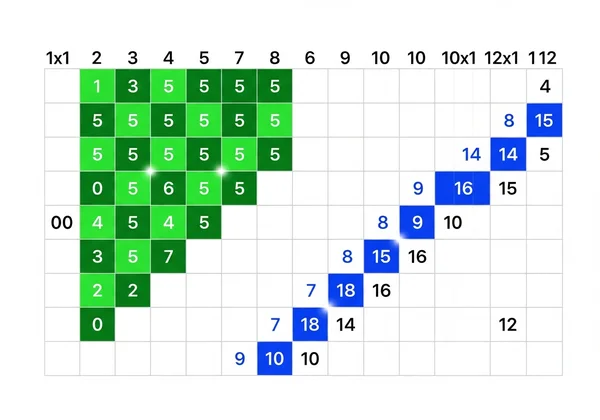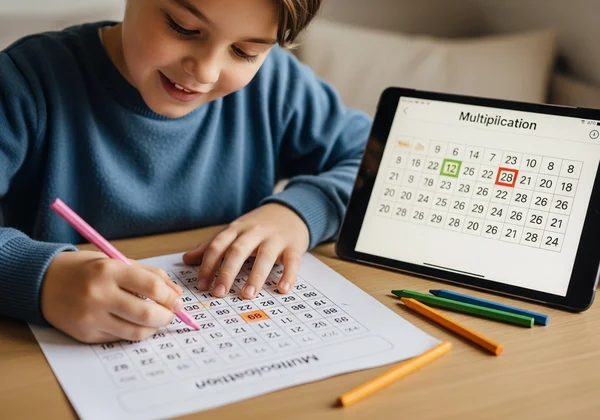Multiplication Chart for Dyscalculia & Math Anxiety
Watching a child struggle with multiplication can be a deeply frustrating experience for any parent or teacher. When simple times tables feel like insurmountable hurdles, it's easy to worry. But what if the challenge isn't about effort, but about how a child's brain is wired for numbers? For many, the root issues are dyscalculia and math anxiety. This guide will help you understand these challenges and show you how a simple multiplication chart can become a powerful, confidence-building tool. How can I help my child learn multiplication when traditional methods fail? The answer lies in shifting from stressful memorization to visual, interactive discovery.
At its core, learning multiplication is about understanding patterns, and that's where visual tools shine. An interactive chart transforms abstract numbers into a tangible, explorable map. By using a resource like the free multiplication table on our site, you provide a low-pressure environment where discovery replaces dread, helping your child build a positive relationship with math.

Understanding Dyscalculia and Math Anxiety in Multiplication Learning
Before we can find the right solution, we must first understand the problem. The struggles your child faces with multiplication are likely not due to a lack of trying. Instead, they may stem from specific neurological or emotional challenges that make learning math incredibly difficult.
What Are Dyscalculia and Math Anxiety?
Think of dyscalculia as the math equivalent of dyslexia. It's a specific learning disability that affects a person's ability to understand, learn, and perform math and number-based operations. A child with dyscalculia might struggle to grasp basic number concepts, have trouble recognizing numerical patterns, or find it nearly impossible to recall math facts. It is one of the most common learning difficulties that directly impacts a student's ability to build a foundation in mathematics.
Math anxiety, on the other hand, is an emotional response. It’s a feeling of tension, apprehension, or fear that interferes with math performance. This anxiety can cause a mental block, making it impossible for a child to access the knowledge they already have. Often, math anxiety develops as a result of repeated negative experiences, time pressure in tests, or feeling left behind in class. These two conditions can exist separately or together, creating a significant barrier to learning.
How These Challenges Impact Learning Multiplication
For a child with dyscalculia, a standard times table chart is just a jumble of random numbers. Rote memorization is ineffective because the neural pathways for number sense are underdeveloped. They can’t "see" the relationship between 3x4 and 4x3 or understand why the 10s times table always ends in zero. They are experiencing genuine math struggles at a cognitive level.
For a child with math anxiety, the pressure to "just memorize" is terrifying. The fear of getting the wrong answer can trigger a fight-or-flight response, flooding their brain with cortisol and shutting down the prefrontal cortex—the very part of the brain responsible for working memory and problem-solving. This is why a child might know the answer one minute and go completely blank the next when put on the spot.

Harnessing Visual Learning for Math Mastery
The good news is that we can bypass these roadblocks by changing our approach. Instead of forcing memorization, we can leverage one of the brain’s most powerful assets: visual processing. Using an interactive visual learning for math tool makes abstract concepts concrete and accessible.
The Power of Pattern Recognition and Visual Memory
Our brains are wired to find patterns, and we process visual information far more efficiently than abstract symbols. A multiplication grid isn't just a list of facts; it's a visual tapestry of interconnected patterns. When a child can see and interact with these patterns, something magical happens. They begin to understand the logic behind multiplication.
For example, by coloring all the multiples of 5 on a chart, a child instantly sees the repeating 5-0-5-0 pattern. By highlighting the diagonal line of square numbers (1, 4, 9, 16…), they form a strong visual memory of these key facts. This focus on pattern recognition builds deep conceptual understanding, which is far more durable than memorized data.

Moving Beyond Rote Memorization with Visual Cues
Rote memorization is often the biggest source of math anxiety. It feels like a high-stakes performance with no safety net. An interactive multiplication chart provides a crucial rote memorization alternative. It transforms learning from a passive act of memorizing to an active process of exploration.
Instead of asking, "What is 7 times 8?", you can invite them to explore. "Let's find 7 times 8 on our chart. What do you notice about the numbers around it?" This low-pressure approach removes fear and encourages curiosity. Children learn that it's okay not to know the answer instantly because they have a reliable tool to help them find it. Over time, this repeated visual and interactive process builds the long-term memory needed for recall, but without the associated stress. You can begin this journey with an interactive chart that makes learning feel like a game.
Adapting Interactive Multiplication Charts as Special Needs Math Tools
A one-size-fits-all approach to education rarely works, especially for students with unique needs. The beauty of an interactive special needs math tools like the one on our site is its adaptability. It can be customized to meet a child exactly where they are.
Customizing the Interactive Chart for Individual Needs
For a child overwhelmed by a full 1-100 grid, you can use color to focus on one number family at a time. Spend a whole session just highlighting the 2s table, talking about how all the answers are even numbers. For a child with cognitive challenges, this simplification is critical. It breaks a massive task into manageable chunks.
You can also use colors to uncover multiplication rules, such as the commutative property (a x b = b x a). By highlighting 4x6 and 6x4, a child can visually confirm they result in the same answer, 24. This isn't just a rule they are told; it's a discovery they make themselves, which is far more powerful.
Integrating Printable Charts for Multi-Sensory Practice
Learning is most effective when it engages multiple senses. While an online tool is fantastic for interactive discovery, printable resources bring a tactile element to the learning process. This strategy creates a powerful form of multi-sensory learning.
After exploring patterns on the screen, a child can use downloadable charts to reinforce their learning offline. Give them a blank chart and some crayons and ask them to color in the patterns they found. This physical act of coloring helps cement the visual information in their memory. Having a printed chart available during homework also serves as a helpful, low-anxiety reference, reducing the fear of getting stuck.

Creating a Low-Pressure Learning Environment
The most important strategy is to create a low-pressure environment. The tool is there to support learning, not to test performance. Celebrate curiosity and effort above all else. Praise your child for noticing a new pattern or for having the courage to try a difficult problem. When the fear of failure is removed, the brain is free to do what it does best: learn. Frame your sessions as "math exploration time" rather than "multiplication practice." This simple shift in language can make a world of difference.
Practical Math Anxiety Tips for Parents and Educators
Managing the emotional side of learning is just as important as teaching the academic content. Here are some practical math anxiety tips to help you support your child and build their confidence.
Focusing on Progress, Not Perfection
Adopt a growth mindset. This means praising the process and the effort, not just the correct answers. Instead of saying, "You're so smart for getting that right," try, "I love how you kept working on that problem even when it was tricky." Acknowledge and celebrate small victories. Mastering the 2s and 10s tables is a huge accomplishment! Focusing on incremental progress shows a child that learning is a journey, not a race, and helps build resilient math confidence.
Incorporating Play and Fun into Learning Sessions
Turn practice into a game. Use the interactive chart as a bingo board, calling out equations like "5 times 5!" and having your child find and color the answer. Challenge each other to find patterns. Who can find the most multiples of 9? When learning is associated with play and connection, it rewires the brain to see math as a source of enjoyment rather than fear. A great way to start is with our fun tool.
When to Seek Additional Support
While tools and strategies can make a significant difference, it's also important to recognize when more help is needed. If your child’s struggles with math are severe, persistent, and causing significant distress, it may be time to speak with their teacher, school counselor, or an educational psychologist. A formal evaluation can help identify specific learning disabilities like dyscalculia and unlock access to specialized support and accommodations. Seeking help is a sign of strength and advocacy for your child.
Your Next Steps to Empowering Math Learners
Remember, dyscalculia and math anxiety are significant hurdles, but they are not insurmountable. By embracing visual exploration over stressful memorization, you can empower children to build genuine number sense and enduring confidence. Think of an interactive multiplication chart not just as a tool, but as a friendly guide connecting abstract concepts to your child's natural learning style. It provides a safe, engaging path to transforming challenges into triumphs. You have the power to change your child’s relationship with math—start today by exploring the free interactive tool and discover the patterns of multiplication together.
Frequently Asked Questions About Supporting Math Learning
How can I help my child with dyscalculia learn multiplication effectively?
The most effective method is to use visual and hands-on tools. An interactive multiplication chart allows them to see patterns and relationships between numbers, which is more effective than trying to memorize isolated facts. Focus on one number family at a time and use colors to make the patterns stand out.
What are the best strategies for reducing math anxiety during times table practice?
Create a low-pressure environment by focusing on exploration over performance. Use games, celebrate effort rather than just correct answers, and remove any time limits. Allowing your child to use a tool like an online times table as a support can also reduce the fear of getting stuck.
Are interactive multiplication charts truly beneficial for students with learning difficulties?
Yes, absolutely. For students with challenges like dyscalculia or attention issues, an interactive chart offers a multi-sensory, self-paced learning experience. The immediate visual feedback and the ability to customize the chart to focus on specific areas make it a highly effective and adaptable educational tool.
Where can I find free, adapted resources for teaching multiplication to struggling students?
You can find a powerful, free, and perfectly adapted resource right here. The interactive learning platform offers a fully interactive chart with color-coding features and free printable versions, designed specifically to support all learners in a fun and engaging way.